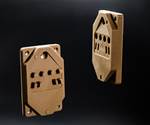CAMX Additive Manufacturing Workshop Speaker: CEAD
The Additive Manufacturing Workshop for Composites at CAMX will take place on September 25 in Anaheim, California and will explore the evolution of 3D printing technology and fiber reinforcement.

CFAM Prime gantry-based machine with a 4m x 2m x 1.5m build volume.
At the Additive Manufacturing Workshop at this year’s CAMX, Charléne van Wingerden, who is in charge of business development at CEAD, will deliver a presentation on “Continuous Fibre Additive Manufacturing, 3D Printing Large Composite Parts for the Industry Sectors.”
Development of the CFAM technology started in 2017 to develop printing of thermoplastic composite materials for industry end applications such as facade cladding elements, train exterior panels and autoclave molds. Up to this moment printing with continuous fibers has not been developed for industry applications, always on small scale with very low speeds. To be able to print these parts efficiently the technology needed to take an additional leap, so that it is able to print on a large size and high speed.
The CFAM technology reportedly does exactly that. The first machine launched with this technology is said to make it possible to print parts up to 4m × 2m × 1.5m with an average output of 15 kg/hr. and a maximum output of 25kg/hr. This is more than 100 times faster than conventional 3D printers.
The process where CEAD combines a continuous fiber and thermoplastic material at this scale is unique and patented. This can either be a glass- or carbon fiber that is being inserted in the high-pressure area from the single screw extruder. By using a single screw extruder virtually all thermoplastic materials can be used, from PP up to PEEK. The way that this technology combines thermoplastics and fibers is distinctive from other technologies and enables the rapid production of large parts for industry use.
The session will take place on Wednesday September 25 from 1:45 p.m – 2:15 p.m.
The workshop’s agenda and registration event details are available at www.additiveconference.com/composites.
Related Content
-
VulcanForms Is Forging a New Model for Large-Scale Production (and It's More Than 3D Printing)
The MIT spinout leverages proprietary high-power laser powder bed fusion alongside machining in the context of digitized, cost-effective and “maniacally focused” production.
-
Aircraft Ducts 3D Printed in Composite Instead of Metal: The Cool Parts Show #68
Eaton’s new reinforced PEKK, tailored to aircraft applications, provides a cheaper and faster way to make ducts compared to formed aluminum.
-
“Mantis” AM System for Spacecraft Uses Induction for Deposition
The metal 3D printing system melts wire without lasers. 30-foot-diameter parts are built on a rotary-feed system that eliminates the need for a large machine frame or gantry.














